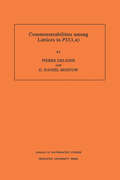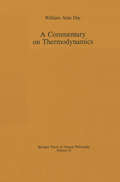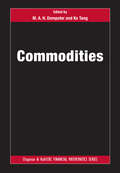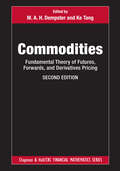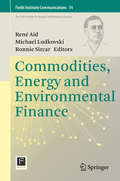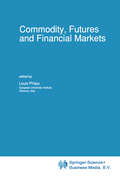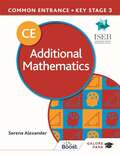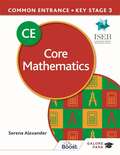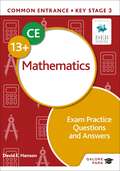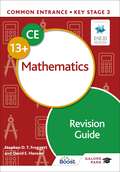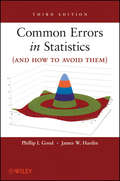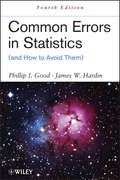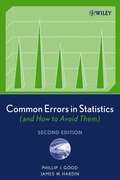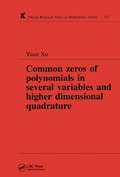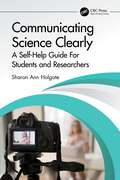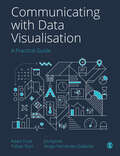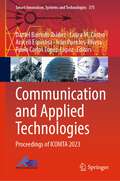- Table View
- List View
Commensurabilities among Lattices in PU (1,n). (AM-132), Volume 132 (PDF)
by Pierre Deligne G. Daniel MostowThe first part of this monograph is devoted to a characterization of hypergeometric-like functions, that is, twists of hypergeometric functions in n-variables. These are treated as an (n+1) dimensional vector space of multivalued locally holomorphic functions defined on the space of n+3 tuples of distinct points on the projective line P modulo, the diagonal section of Auto P=m. For n=1, the characterization may be regarded as a generalization of Riemann's classical theorem characterizing hypergeometric functions by their exponents at three singular points. This characterization permits the authors to compare monodromy groups corresponding to different parameters and to prove commensurability modulo inner automorphisms of PU(1,n). The book includes an investigation of elliptic and parabolic monodromy groups, as well as hyperbolic monodromy groups. The former play a role in the proof that a surprising number of lattices in PU(1,2) constructed as the fundamental groups of compact complex surfaces with constant holomorphic curvature are in fact conjugate to projective monodromy groups of hypergeometric functions. The characterization of hypergeometric-like functions by their exponents at the divisors "at infinity" permits one to prove generalizations in n-variables of the Kummer identities for n-1 involving quadratic and cubic changes of the variable.
A Commentary on Thermodynamics (Springer Tracts in Natural Philosophy #32)
by William A. DayThe aim of this book is to comment on, and clarify, the mathematical aspects of the theory of thermodynamics. The standard presentations of the subject are often beset by a number of obscurities associated with the words "state", "reversible", "irreversible", and "quasi-static". This book is written in the belief that such obscurities are best removed not by the formal axiomatization of thermodynamics, but by setting the theory in the wider context of a genuine field theory which incorporates the effects of heat conduction and intertia, and proving appropriate results about the governing differential equations of this field theory. Even in the simplest one-dimensional case it is a nontrivial task to carry through the details of this program, and many challenging problems remain open.
Commodities
by M. A. H. Dempster Ke TangSince a major source of income for many countries comes from exporting commodities, price discovery and information transmission between commodity futures markets are key issues for continued economic development.This book covers the fundamental theory of and derivatives pricing for major commodity markets as well as the interaction between commodi
Commodities: Fundamental Theory of Futures, Forwards, and Derivatives Pricing (Chapman and Hall/CRC Financial Mathematics Series)
by M. A. H. Dempster Ke TangSince a major source of income for many countries comes from exporting commodities, price discovery and information transmission between commodity futures markets are key issues for continued economic development. Commodities: Fundamental Theory of Futures, Forwards, and Derivatives Pricing, Second Edition covers the fundamental theory of and derivatives pricing for major commodity markets, as well as the interaction between commodity prices, the real economy, and other financial markets. After a thoroughly updated and extensive theoretical and practical introduction, this new edition of the book is divided into five parts – the fifth of which is entirely new material covering cutting-edge developments. Oil Products considers the structural changes in the demand and supply for hedging services that are increasingly determining the price of oil Other Commodities examines markets related to agricultural commodities, including natural gas, wine, soybeans, corn, gold, silver, copper, and other metals Commodity Prices and Financial Markets investigates the contemporary aspects of the financialization of commodities, including stocks, bonds, futures, currency markets, index products, and exchange traded funds Electricity Markets supplies an overview of the current and future modelling of electricity markets Contemporary Topics discuss rough volatility, order book trading, cryptocurrencies, text mining for price dynamics and flash crashes
Commodities: Fundamental Theory of Futures, Forwards, and Derivatives Pricing (Chapman and Hall/CRC Financial Mathematics Series)
by M.A.H. DempsterSince a major source of income for many countries comes from exporting commodities, price discovery and information transmission between commodity futures markets are key issues for continued economic development. Commodities: Fundamental Theory of Futures, Forwards, and Derivatives Pricing, Second Edition covers the fundamental theory of and derivatives pricing for major commodity markets, as well as the interaction between commodity prices, the real economy, and other financial markets. After a thoroughly updated and extensive theoretical and practical introduction, this new edition of the book is divided into five parts – the fifth of which is entirely new material covering cutting-edge developments. Oil Products considers the structural changes in the demand and supply for hedging services that are increasingly determining the price of oil Other Commodities examines markets related to agricultural commodities, including natural gas, wine, soybeans, corn, gold, silver, copper, and other metals Commodity Prices and Financial Markets investigates the contemporary aspects of the financialization of commodities, including stocks, bonds, futures, currency markets, index products, and exchange traded funds Electricity Markets supplies an overview of the current and future modelling of electricity markets Contemporary Topics discuss rough volatility, order book trading, cryptocurrencies, text mining for price dynamics and flash crashes
Commodities, Energy and Environmental Finance (Fields Institute Communications #74)
by René Aïd Michael Ludkovski Ronnie SircarThis volume is a collection of chapters covering the latest developments in applications of financial mathematics and statistics to topics in energy, commodity financial markets and environmental economics. The research presented is based on the presentations and discussions that took place during the Fields Institute Focus Program on Commodities, Energy and Environmental Finance in August 2013. The authors include applied mathematicians, economists and industry practitioners, providing for a multi-disciplinary spectrum of perspectives on the subject. The volume consists of four sections: Electricity Markets; Real Options; Trading in Commodity Markets; and Oligopolistic Models for Energy Production. Taken together, the chapters give a comprehensive summary of the current state of the art in quantitative analysis of commodities and energy finance. The topics covered include structural models of electricity markets, financialization of commodities, valuation of commodity real options, game-theory analysis of exhaustible resource management and analysis of commodity ETFs. The volume also includes two survey articles that provide a source for new researchers interested in getting into these topics.
Commodity, Futures and Financial Markets (Advanced Studies in Theoretical and Applied Econometrics #21)
by L. PhlipsLouis Phlips The stabilisation of primary commodity prices, and the related issue of the stabilisation of export earnings of developing countries, have traditionally been studied without reference to the futures markets (that exist or could exist) for these commodities. These futures markets have in turn been s~udied in isolation. The same is true for the new developments on financial markets. Over the last few years, in particular sine the 1985 tin crisis and the October 1987 stock exchange crisis, it has become evident that there are inter actions between commodity, futures, and financial markets and that these inter actions are very important. The more so as trade on futures and financial markets has shown a spectacular increase. This volume brings together a number of recent and unpublished papers on these interactions by leading specialists (and their students). A first set of papers examines how the use of futures markets could help stabilising export earnings of developing countries and how this compares to the rather unsuccessful UNCTAD type interventions via buffer stocks, pegged prices and cartels. A second set of papers faces the fact, largely ignored in the literature, that commodity prices are determined in foreign currencies, with the result that developing countries suffer from the volatility of exchange rates of these currencies (even in cases where commodity prices are relatively stable). Financial markets are thus explicitly linked to futures and commodity markets.
Common Entrance 13+ Additional Mathematics for ISEB CE and KS3
by Serena AlexanderExam board: ISEB Level: 13+ CE and KS3 Subject: Mathematics First teaching: September 2021 First exams: November 2022Serena Alexander brings her renowned passion and love of Mathematics to help you stretch and challenge pupils aiming for the Additional Mathematics paper or the Common Academic Scholarship Exam (CASE). The resource is packed with activities, examples and exercises to help pupils develop a comprehensive knowledge of Mathematics.· Push your pupils to achieve high scores: Covers all content for the Core Mathematics paper, with new material for the Additional Mathematics paper and the Common Academic Scholarship Exam (CASE).· Ensure an in-depth knowledge of Mathematics: Chapters include Fractions and Decimals, Geometry (with more of a focus on angle calculations using algebra), and Trigonometry.· Develop a wider understanding with projects: End-of-chapter projects and investigations cover current affairs, mathematical proof and mathematical paradox, and using probability to model real-life scenarios.· Support your pupils in developing their analytical and research skills: Investigations include Mersenne primes, perfect numbers and Goldbach's conjecture.· Encourage your pupils to think beyond Mathematics: Cross-curricular boxes inform pupils where mathematical skills may be required in other subjects (including other examination subjects, PSHEE and ICT) with suggestions of cross-curricular activities.· Guide your pupils to develop an understanding of the role of Mathematics in the world: SCEE (Social, Cultural, Empathy and Environmental) boxes encourage pupils to learn the mathematical relevance in society, links to different cultures including their role in the history of Mathematics, and the use of Mathematics in exploring environmental issues.Accompanying answers available in a paid-for PDF download at galorepark.co.uk (ISBN: 9781398321403).
Common Entrance 13+ Core Mathematics for ISEB CE and KS3
by Serena AlexanderExam board: ISEB Level: 13+ CE and KS3 Subject: Mathematics First teaching: September 2021 First exams: November 2022With more than 30 years' experience teaching Mathematics, Serena Alexander guides you through the ISEB 13+ CE specification for Mathematics, enabling you to support your pupils on their journey to becoming proficient and confident in Mathematics.· Cover all the content for the Core paper: Chapters include Powers and Roots, Metric and Other Units (with a new section on Money), and Geometry.· Bring out the best in every pupil: Challenging tasks and extension exercises in every chapter.· Guide pupils' development of investigative thinking, problem solving and reasoning skills: New investigations and puzzles include matchstick puzzles, Countdown and other number card investigations, and how to solve number puzzles found in newspapers.· Develop knowledge and analytical research with in-depth projects: New projects include current affairs and using a spreadsheet to solve mathematical problems and to support charitable fundraising.· Encourage your pupils to think beyond Mathematics: Cross-curricular boxes inform pupils where mathematical skills may be required in other subjects, with suggestions of activities.· Develop your pupils' understanding of their place in the world: Assist pupils in demonstrating cultural and environmental awareness and empathy with SCEE (Social, Cultural, Empathy and Environmental) boxes throughout.Accompanying answers available in a paid-for PDF download at galorepark.co.uk (ISBN: 9781398321489).
Common Entrance 13+ Mathematics Exam Practice Questions and Answers
by David E HansonExam board: ISEB Level: 13+ CE and KS3 Subject: Maths First exams: November 2022Improve exam technique and build confidence to ensure success in the CE 13+ Mathematics exams with these practice questions in the style of the ISEB exams.· Prepare for all papers: questions cover all areas of the specification for the Core and Additional Papers.· Guidance on the exam: practice applying knowledge and experience to answer all possible exam questions and improve problem solving skills.· Identify gaps in knowledge: answers included to help pinpoint areas for improvement.Pair with Common Entrance 13+ Mathematics Revision Guide for comprehensive exam preparation (ISBN: 9781398340916).
Common Entrance 13+ Mathematics Revision Guide
by Stephen Froggatt David E HansonExam board: ISEB Level: 13+ CE and KS3 Subject: Maths First exams: November 2022This comprehensive, ISEB-endorsed guide for Mathematics focuses on consolidating knowledge and covering all the skills needed to meet the requirements of the ISEB CE 13+ exam.· Extensive coverage of all Core and Additional topics: number, algebra, measurement, geometry, probability and statistics.· Additional chapters: basic skills, mental strategies, problem solving skills, puzzles and projects.· Improve knowledge and skills: practice all types of questions from mental arithmetic to thought-provoking puzzles as well as a glossary of mathematical terms.· Prepare for the exam: 'make sure you know' summary per chapter, exam-style questions, 'test yourself' questions and guidance to support thinking, working out and planning a well-structured answer.Continue your revision with Common Entrance 13+ Mathematics Exam Practice Questions and Answers (ISBN: 9781398326491).
Common Errors in Statistics (and How to Avoid Them)
by Phillip I. Good James W. HardinPraise for the Second Edition "All statistics students and teachers will find in this book a friendly and intelligentguide to . . . applied statistics in practice." —Journal of Applied Statistics ". . . a very engaging and valuable book for all who use statistics in any setting." —CHOICE ". . . a concise guide to the basics of statistics, replete with examples . . . a valuablereference for more advanced statisticians as well." —MAA Reviews Now in its Third Edition, the highly readable Common Errors in Statistics (and How to Avoid Them) continues to serve as a thorough and straightforward discussion of basic statistical methods, presentations, approaches, and modeling techniques. Further enriched with new examples and counterexamples from the latest research as well as added coverage of relevant topics, this new edition of the benchmark book addresses popular mistakes often made in data collection and provides an indispensable guide to accurate statistical analysis and reporting. The authors' emphasis on careful practice, combined with a focus on the development of solutions, reveals the true value of statistics when applied correctly in any area of research. The Third Edition has been considerably expanded and revised to include: A new chapter on data quality assessment A new chapter on correlated data An expanded chapter on data analysis covering categorical and ordinal data, continuous measurements, and time-to-event data, including sections on factorial and crossover designs Revamped exercises with a stronger emphasis on solutions An extended chapter on report preparation New sections on factor analysis as well as Poisson and negative binomial regression Providing valuable, up-to-date information in the same user-friendly format as its predecessor, Common Errors in Statistics (and How to Avoid Them), Third Edition is an excellent book for students and professionals in industry, government, medicine, and the social sciences.
Common Errors in Statistics (and How to Avoid Them)
by Phillip I. Good James W. HardinPraise for Common Errors in Statistics (and How to Avoid Them) "A very engaging and valuable book for all who use statistics in any setting." —CHOICE "Addresses popular mistakes often made in data collection and provides an indispensable guide to accurate statistical analysis and reporting. The authors' emphasis on careful practice, combined with a focus on the development of solutions, reveals the true value of statistics when applied correctly in any area of research." —MAA Reviews Common Errors in Statistics (and How to Avoid Them), Fourth Edition provides a mathematically rigorous, yet readily accessible foundation in statistics for experienced readers as well as students learning to design and complete experiments, surveys, and clinical trials. Providing a consistent level of coherency throughout, the highly readable Fourth Edition focuses on debunking popular myths, analyzing common mistakes, and instructing readers on how to choose the appropriate statistical technique to address their specific task. The authors begin with an introduction to the main sources of error and provide techniques for avoiding them. Subsequent chapters outline key methods and practices for accurate analysis, reporting, and model building. The Fourth Edition features newly added topics, including: Baseline data Detecting fraud Linear regression versus linear behavior Case control studies Minimum reporting requirements Non-random samples The book concludes with a glossary that outlines key terms, and an extensive bibliography with several hundred citations directing readers to resources for further study. Presented in an easy-to-follow style, Common Errors in Statistics, Fourth Edition is an excellent book for students and professionals in industry, government, medicine, and the social sciences.
Common Errors in Statistics (and How to Avoid Them)
by Phillip I. Good James W. HardinPraise for the Second Edition "All statistics students and teachers will find in this book a friendly and intelligentguide to . . . applied statistics in practice." —Journal of Applied Statistics ". . . a very engaging and valuable book for all who use statistics in any setting." —CHOICE ". . . a concise guide to the basics of statistics, replete with examples . . . a valuablereference for more advanced statisticians as well." —MAA Reviews Now in its Third Edition, the highly readable Common Errors in Statistics (and How to Avoid Them) continues to serve as a thorough and straightforward discussion of basic statistical methods, presentations, approaches, and modeling techniques. Further enriched with new examples and counterexamples from the latest research as well as added coverage of relevant topics, this new edition of the benchmark book addresses popular mistakes often made in data collection and provides an indispensable guide to accurate statistical analysis and reporting. The authors' emphasis on careful practice, combined with a focus on the development of solutions, reveals the true value of statistics when applied correctly in any area of research. The Third Edition has been considerably expanded and revised to include: A new chapter on data quality assessment A new chapter on correlated data An expanded chapter on data analysis covering categorical and ordinal data, continuous measurements, and time-to-event data, including sections on factorial and crossover designs Revamped exercises with a stronger emphasis on solutions An extended chapter on report preparation New sections on factor analysis as well as Poisson and negative binomial regression Providing valuable, up-to-date information in the same user-friendly format as its predecessor, Common Errors in Statistics (and How to Avoid Them), Third Edition is an excellent book for students and professionals in industry, government, medicine, and the social sciences.
Common Errors in Statistics (and How to Avoid Them): Introduction To Statistics Through Resampling Methods And Microsoft Office Excel
by Phillip I. Good James W. HardinPraise for Common Errors in Statistics (and How to Avoid Them) "A very engaging and valuable book for all who use statistics in any setting." —CHOICE "Addresses popular mistakes often made in data collection and provides an indispensable guide to accurate statistical analysis and reporting. The authors' emphasis on careful practice, combined with a focus on the development of solutions, reveals the true value of statistics when applied correctly in any area of research." —MAA Reviews Common Errors in Statistics (and How to Avoid Them), Fourth Edition provides a mathematically rigorous, yet readily accessible foundation in statistics for experienced readers as well as students learning to design and complete experiments, surveys, and clinical trials. Providing a consistent level of coherency throughout, the highly readable Fourth Edition focuses on debunking popular myths, analyzing common mistakes, and instructing readers on how to choose the appropriate statistical technique to address their specific task. The authors begin with an introduction to the main sources of error and provide techniques for avoiding them. Subsequent chapters outline key methods and practices for accurate analysis, reporting, and model building. The Fourth Edition features newly added topics, including: Baseline data Detecting fraud Linear regression versus linear behavior Case control studies Minimum reporting requirements Non-random samples The book concludes with a glossary that outlines key terms, and an extensive bibliography with several hundred citations directing readers to resources for further study. Presented in an easy-to-follow style, Common Errors in Statistics, Fourth Edition is an excellent book for students and professionals in industry, government, medicine, and the social sciences.
Common Errors in Statistics (and How to Avoid Them)
by Phillip I. Good James W. HardinPraise for the First Edition of Common Errors in Statistics " . . . let me recommend Common Errors to all those who interact with statistics, whatever their level of statistical understanding . . . " --Stats 40 " . . . written . . . for the people who define good practice rather than seek to emulate it." --Journal of Biopharmaceutical Statistics " . . . highly informative, enjoyable to read, and of potential use to a broad audience. It is a book that should be on the reference shelf of many statisticians and researchers." --The American Statistician " . . . I found this book the most easily readable statistics book ever. The credit for this certainly goes to Phillip Good." --E-STREAMS A tried-and-true guide to the proper application of statistics Now in a second edition, the highly readable Common Errors in Statistics (and How to Avoid Them) lays a mathematically rigorous and readily accessible foundation for understanding statistical procedures, problems, and solutions. This handy field guide analyzes common mistakes, debunks popular myths, and helps readers to choose the best and most effective statistical technique for each of their tasks. Written for both the newly minted academic and the professional who uses statistics in their work, the book covers creating a research plan, formulating a hypothesis, specifying sample size, checking assumptions, interpreting p-values and confidence intervals, building a model, data mining, Bayes' Theorem, the bootstrap, and many other topics. The Second Edition has been extensively revised to include: * Additional charts and graphs * Two new chapters, Interpreting Reports and Which Regression Method? * New sections on practical versus statistical significance and nonuniqueness in multivariate regression * Added material from the authors' online courses at statistics.com * New material on unbalanced designs, report interpretation, and alternative modeling methods With a final emphasis on both finding solutions and the great value of statistics when applied in the proper context, this book is eminently useful to students and professionals in the fields of research, industry, medicine, and government.
Common Zeros of Polynominals in Several Variables and Higher Dimensional Quadrature (Chapman And Hall/crc Research Notes In Mathematics Ser.)
by Yuan XuPresents a systematic study of the common zeros of polynomials in several variables which are related to higher dimensional quadrature. The author uses a new approach which is based on the recent development of orthogonal polynomials in several variables and differs significantly from the previous ones based on algebraic ideal theory. Featuring a great deal of new work, new theorems and, in many cases, new proofs, this self-contained work will be of great interest to researchers in numerical analysis, the theory of orthogonal polynomials and related subjects.
Common Zeros of Polynominals in Several Variables and Higher Dimensional Quadrature (Chapman And Hall/crc Research Notes In Mathematics Ser.)
by Yuan XuPresents a systematic study of the common zeros of polynomials in several variables which are related to higher dimensional quadrature. The author uses a new approach which is based on the recent development of orthogonal polynomials in several variables and differs significantly from the previous ones based on algebraic ideal theory. Featuring a great deal of new work, new theorems and, in many cases, new proofs, this self-contained work will be of great interest to researchers in numerical analysis, the theory of orthogonal polynomials and related subjects.
Communicating Science Clearly: A Self-Help Guide For Students and Researchers
by Sharon Ann HolgateThis unique self-help guide equips undergraduates, postgraduate students, and early career researchers within the sciences with transferrable communication skills that they can adapt and refer back to as they progress through their careers. It provides practical guidance on how to best communicate science in a range of different settings. This book facilitates clear and concise communication in both academic scenarios and the workplace. It covers settings ranging from job interviews, through conference presentations, to explaining your research to the general public. It is illustrated with first-hand experiences, top tips, and "dos and don’ts" to demonstrate best practices. It will also be a valuable guide for established academics who would like a refresher or a guide to new avenues of science communication, such as podcasts. Key Features: Written by an award-winning professional science journalist and broadcaster with 25 years’ experience, including writing for national newspapers, devising and presenting programmes for BBC Radio 4, and being interviewed on radio, TV, video, and podcasts Covers science communication in a broad range of settings including peer-to-peer, to your manager, at job interviews, and during media appearances Includes advice from a range of experts who communicate professionally, including a radio producer, a TV presenter, actors and entertainers, and scientists Additional video material to accompany this book can be found here: https://www.youtube.com/playlist?list=PLLUWyRwmgFlW7_NrNupeuiJ86OxIWHZ6I. Sharon Ann Holgate is a freelance science writer and broadcaster. She has presented on BBC Radio 4 and the BBC World Service, and presented video podcasts for medical research charity the Myrovlytis Trust. She earned a D.Phil in physics from the University of Sussex, where she was a Visiting Fellow in Physics and Astronomy for nine years. Her articles have appeared in Science, Science Careers, New Scientist, The Times Higher Education Supplement, The Times Literary Supplement, Flipside, E&T, Focus, Physics World, Interactions, Materials World, Modern Astronomer, and Astronomy Now. She was also shortlisted for the radio programme category of the Association of British Science Writers' Awards in 2005, and for the Aventis Prizes for Science Books Junior Prize in 2003. Dr. Holgate was the recipient of the Institute of Physics 2022 William Thomson, Lord Kelvin Medal and Prize for communicating science to a wide variety of audiences and for positive representations of scientists from non-traditional backgrounds. She has also received the Institute of Physics Young Professional Physicist of the Year Award and a Merit Award in the Daily Telegraph Young Science Writer of the Year competition. She is the author of the undergraduate textbook Understanding Solid State Physics, which is currently in its second edition and used as a core text in universities around the world.
Communicating Science Clearly: A Self-Help Guide For Students and Researchers
by Sharon Ann HolgateThis unique self-help guide equips undergraduates, postgraduate students, and early career researchers within the sciences with transferrable communication skills that they can adapt and refer back to as they progress through their careers. It provides practical guidance on how to best communicate science in a range of different settings. This book facilitates clear and concise communication in both academic scenarios and the workplace. It covers settings ranging from job interviews, through conference presentations, to explaining your research to the general public. It is illustrated with first-hand experiences, top tips, and "dos and don’ts" to demonstrate best practices. It will also be a valuable guide for established academics who would like a refresher or a guide to new avenues of science communication, such as podcasts. Key Features: Written by an award-winning professional science journalist and broadcaster with 25 years’ experience, including writing for national newspapers, devising and presenting programmes for BBC Radio 4, and being interviewed on radio, TV, video, and podcasts Covers science communication in a broad range of settings including peer-to-peer, to your manager, at job interviews, and during media appearances Includes advice from a range of experts who communicate professionally, including a radio producer, a TV presenter, actors and entertainers, and scientists Additional video material to accompany this book can be found here: https://www.youtube.com/playlist?list=PLLUWyRwmgFlW7_NrNupeuiJ86OxIWHZ6I. Sharon Ann Holgate is a freelance science writer and broadcaster. She has presented on BBC Radio 4 and the BBC World Service, and presented video podcasts for medical research charity the Myrovlytis Trust. She earned a D.Phil in physics from the University of Sussex, where she was a Visiting Fellow in Physics and Astronomy for nine years. Her articles have appeared in Science, Science Careers, New Scientist, The Times Higher Education Supplement, The Times Literary Supplement, Flipside, E&T, Focus, Physics World, Interactions, Materials World, Modern Astronomer, and Astronomy Now. She was also shortlisted for the radio programme category of the Association of British Science Writers' Awards in 2005, and for the Aventis Prizes for Science Books Junior Prize in 2003. Dr. Holgate was the recipient of the Institute of Physics 2022 William Thomson, Lord Kelvin Medal and Prize for communicating science to a wide variety of audiences and for positive representations of scientists from non-traditional backgrounds. She has also received the Institute of Physics Young Professional Physicist of the Year Award and a Merit Award in the Daily Telegraph Young Science Writer of the Year competition. She is the author of the undergraduate textbook Understanding Solid State Physics, which is currently in its second edition and used as a core text in universities around the world.
Communicating with Data Visualisation: A Practical Guide
by Adam Frost Tobias Sturt Jim Kynvin Sergio GallardoHow can you transform a spreadsheet of numbers into a clear, compelling story that your audience will want to pass on? This book is a step-by-step guide to bringing data to life through visualisations, from static charts and maps to interactive infographics and motion graphics. Introducing a four-step framework to creating engaging and innovative visualisations, it helps you to: · Find the human stories in your datasets · Design a visual story that will resonate with your audience · Make a clear, persuasive visual that represents your data truthfully · Refine your work to ensure your visual expresses your story in the best possible way. This book also includes a portfolio of best-practice examples and annotated templates to help you choose the right visual for the right audience, and repurpose your work for different contexts.
Communicating with Data Visualisation: A Practical Guide
by Adam Frost Tobias Sturt Jim Kynvin Sergio GallardoHow can you transform a spreadsheet of numbers into a clear, compelling story that your audience will want to pass on? This book is a step-by-step guide to bringing data to life through visualisations, from static charts and maps to interactive infographics and motion graphics. Introducing a four-step framework to creating engaging and innovative visualisations, it helps you to: · Find the human stories in your datasets · Design a visual story that will resonate with your audience · Make a clear, persuasive visual that represents your data truthfully · Refine your work to ensure your visual expresses your story in the best possible way. This book also includes a portfolio of best-practice examples and annotated templates to help you choose the right visual for the right audience, and repurpose your work for different contexts.
Communicating with Data Visualisation: A Practical Guide
by Adam Frost Tobias Sturt Jim Kynvin Sergio GallardoHow can you transform a spreadsheet of numbers into a clear, compelling story that your audience will want to pass on? This book is a step-by-step guide to bringing data to life through visualisations, from static charts and maps to interactive infographics and motion graphics. Introducing a four-step framework to creating engaging and innovative visualisations, it helps you to: · Find the human stories in your datasets · Design a visual story that will resonate with your audience · Make a clear, persuasive visual that represents your data truthfully · Refine your work to ensure your visual expresses your story in the best possible way. This book also includes a portfolio of best-practice examples and annotated templates to help you choose the right visual for the right audience, and repurpose your work for different contexts.
Communication and Applied Technologies: Proceedings of ICOMTA 2023 (Smart Innovation, Systems and Technologies #375)
by Daniel Barredo Ibáñez Laura M. Castro Araceli Espinosa Iván Puentes-Rivera Paulo Carlos López-LópezThis book features selected papers from the International Conference on Communication and Applied Technologies (ICOMTA 2023), jointly organized by the Colombian Association of Journalism and Science Communication (Colombia), and the Benemerita Universidad Autonoma de Puebla (Mexico); and as collaborators at the Universidad de Málaga (Spain), Universidade de Vigo (Spain), Universidade de Santiago de Compostela-Equipo de Investigaciones Políticas (Spain), Red Internacional de Gestión de la Comunicación (XESCOM),the International Media Management Academic Association (IMMAA), Red de Investigadores en Comunicación de Ecuador (RICE), and Observatorio Interuniversitario de Medios Ecuatorianos (OIME), during 6 – 8 September 2023. It covers recent advances in the field of digital communication and processes, digital social media, software, big data, data mining and intelligent systems.
